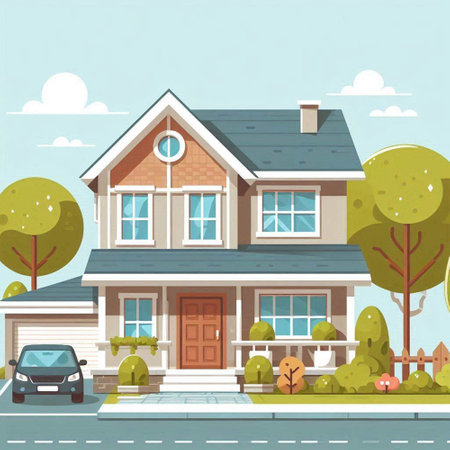1. Market Research and Property Acquisition
Before you swing a hammer or hire a contractor, the first step in flipping a house is doing your homework. Understanding the local real estate market is key to making smart decisions that lead to profit.
Understand the Local Real Estate Market
Start by researching home prices, inventory levels, and average days on market in your target area. This helps you determine whether its a buyer’s or seller’s market and what types of homes are in demand.
Key Data Points to Look For:
| Metric | Why It Matters |
|---|---|
| Median Home Price | Helps you gauge affordability and potential resale value |
| Days on Market (DOM) | Shows how quickly homes are selling in the area |
| Inventory Levels | Indicates competition; low inventory often means higher demand |
Identify Up-and-Coming Neighborhoods
Look for areas that are showing signs of growth—new businesses, public infrastructure projects, or younger populations moving in. These neighborhoods often offer lower purchase prices with high upside potential.
Tips to Spot Hot Neighborhoods:
- Check local development plans or city council announcements
- Talk to local real estate agents about trending areas
- Observe where investors and builders are active
Analyze Comparable Sales (Comps)
You’ll want to study recent sales of similar homes in the neighborhood to estimate the after-repair value (ARV). Comps should be similar in size, age, condition, and location.
What Makes a Good Comp?
- Sold within the last 3–6 months
- Within half a mile of the property youre considering
- Similar square footage and number of bedrooms/bathrooms
Secure Funding for Your Flip
You’ll need capital not only to purchase the property but also to cover renovation costs. There are several financing options available depending on your financial situation and goals.
| Funding Option | Description | Best For |
|---|---|---|
| Cash Purchase | No mortgage involved; faster closing process | Investors with significant capital |
| Hard Money Loan | Short-term loan based on property value after rehab | Flippers needing quick access to funds |
| Private Lenders | Loans from individuals rather than institutions | Experienced flippers with investor networks |
| Traditional Mortgage (limited use) | Might be used for light cosmetic flips but less common due to time constraints | Owner-occupied flips or long-term investors |
The success of your flip starts here—with careful research and smart buying decisions. Get this part right, and youre already halfway to turning a profit.
2. Financial Planning and Budgeting
Before you swing a hammer or sign any contracts, its essential to get your finances in order. Smart budgeting can be the difference between a profitable flip and a financial flop. Heres how to plan your numbers right from the start.
Determine Your Renovation Budget
Start by figuring out how much money youll need for renovations. Walk through the property and list everything that needs fixing or upgrading—think kitchen remodels, flooring, roofing, HVAC systems, plumbing, and paint. Then, get quotes from contractors or use past experience to estimate costs.
Be sure to include a buffer (typically 10-20%) for unexpected expenses. Surprises are common in house flipping, especially with older homes.
Sample Renovation Budget
| Renovation Item | Estimated Cost |
|---|---|
| Kitchen Remodel | $15,000 |
| Bathroom Upgrades | $8,000 |
| Flooring Replacement | $6,000 |
| Painting (Interior & Exterior) | $5,000 |
| HVAC Repair/Replacement | $4,500 |
| Total Estimated Cost | $38,500 |
Account for Holding Costs
Holding costs are the ongoing expenses you’ll pay while owning the property. These include mortgage payments (if financed), property taxes, insurance, utilities, HOA fees (if applicable), and lawn maintenance. Calculate how long you expect to hold the property—from purchase to sale—and multiply these monthly costs accordingly.
Typical Monthly Holding Costs Example
| Cost Category | Monthly Amount |
|---|---|
| Mortgage Payment | $1,200 |
| Property Taxes | $300 |
| Insurance | $150 |
| Utilities & Lawn Care | $200 |
| Total per Month | $1,850 |
Factor in Closing Costs and Selling Fees
You’ll also need to budget for closing costs when buying and selling the home. This includes title fees, escrow charges, transfer taxes, and real estate agent commissions. On average, sellers pay about 6% of the final sale price in agent fees alone.
Selling Expense Estimate (Based on $300,000 Sale Price)
| Fee Type | Estimated Amount | ||||||||||||||||||||||||||||||||||||||||||||||||||||||||
|---|---|---|---|---|---|---|---|---|---|---|---|---|---|---|---|---|---|---|---|---|---|---|---|---|---|---|---|---|---|---|---|---|---|---|---|---|---|---|---|---|---|---|---|---|---|---|---|---|---|---|---|---|---|---|---|---|---|
| Real Estate Agent Commission (6%) | $18,000 | ||||||||||||||||||||||||||||||||||||||||||||||||||||||||
| What to Look For | Why It Matters |
|---|---|
| Valid license and insurance | Protects you from liability and ensures legal compliance |
| Strong references and reviews | Gives insight into past performance and reliability |
| Clear written estimates | Helps you compare costs and avoid hidden fees |
Obtain Necessary Permits
Before any major work begins, make sure all required permits are secured through your local city or county office. Permits are typically needed for structural changes, electrical updates, plumbing modifications, and HVAC work. Skipping this step can result in fines or issues when reselling the property.
Common Renovations That Require Permits:
- Adding or removing walls
- Electrical rewiring
- Plumbing system upgrades
- Roof replacement
- Installing new windows or doors
Manage the Renovation Process
Staying on schedule and within budget is key to a profitable house flip. Create a renovation timeline with milestones for each stage of the project. Regularly check in with your contractor, review progress, and adjust as needed. Keep communication open and document all decisions in writing.
Sample Renovation Timeline:
| Week | Main Tasks |
|---|---|
| 1-2 | Demolition & debris removal |
| 3-4 | Framing & structural repairs |
| 5-6 | Electrical & plumbing rough-ins; inspections |
| 7-8 | Drywall installation & painting |
| 9-10 | Kitchens & bathrooms remodels; flooring installation |
| 11-12 | Curb appeal improvements & final touches |
A well-managed renovation not only prevents delays but also helps maximize your return on investment when its time to sell. Pay attention to design choices that will appeal to buyers in your target market while keeping costs under control.
4. Staging and Marketing the Property
Once renovations are complete, its time to make your flip look its best for potential buyers. This step is all about presentation and getting the word out to attract serious offers. A well-staged and properly marketed home can sell faster and at a higher price.
Stage the Home to Appeal to Target Buyers
Staging helps buyers visualize themselves living in the space. You want to create a warm, inviting environment that highlights the home’s strengths. Think about who your likely buyer is—young professionals, families, or retirees—and stage accordingly. Use neutral colors, modern furniture, and simple decor to appeal to a broad audience.
Key Areas to Stage
| Area | Staging Tips |
|---|---|
| Living Room | Add cozy seating, throw pillows, and soft lighting |
| Kitchen | Clear countertops, add fresh flowers or fruit bowls |
| Main Bedroom | Create a calm vibe with neutral bedding and minimal clutter |
| Bathrooms | Add clean towels, candles, and simple decor items |
Hire a Professional Photographer
Your online listing photos are often the first impression buyers get of your property. Hiring a professional real estate photographer ensures high-quality images that showcase the home’s best features. Great photos can make your listing stand out and attract more attention both online and in print.
List with an Experienced Real Estate Agent
An experienced real estate agent who specializes in flipped homes can be a game-changer. They understand how to market updated properties, price them competitively, and promote them through multiple channels like MLS listings, social media, open houses, and local networks. Make sure to choose someone who knows the local market well and has a strong track record with renovated homes.
The Right Agent Will Help You:
- Create an eye-catching listing description
- Select an attractive listing price based on comps (comparable sales)
A strategic combination of staging, photography, and professional marketing will set your flipped property apart from others on the market—helping you attract serious buyers quickly and maximize your return on investment.
5. Sale and Profit Analysis
Once your flipped property is fully renovated and staged, its time to sell. This step involves more than just listing the home—you need to carefully evaluate offers, negotiate terms, and finally, assess your financial results. Heres how to navigate this important phase of the house flipping process.
Review Offers Carefully
When you start receiving offers from potential buyers, dont jump at the first one. Look at each offers full terms—not just the price. Consider contingencies, financing type, requested closing date, and whether the buyer is pre-approved. Cash offers may be lower but can close faster with fewer complications.
Key Offer Elements to Compare:
| Offer Price | Financing Type | Contingencies | Closing Timeline |
|---|---|---|---|
| $350,000 | Conventional Loan | Inspection & Appraisal | 30 Days |
| $340,000 | Cash | None | 14 Days |
Negotiate the Best Deal
Use competing offers to your advantage. If one buyer offers a higher price but has many contingencies, you can ask them to waive or reduce some conditions—or ask another buyer to match the price. Always work with your real estate agent to ensure youre negotiating within legal and ethical boundaries.
Close the Sale
The closing process includes signing paperwork, transferring ownership, and ensuring all agreed-upon repairs or credits are handled. A title company or attorney typically facilitates this in most U.S. states. Be sure all final walkthroughs and inspections are completed as required by the contract.
Analyze Your Return on Investment (ROI)
After closing the sale, it’s time to crunch the numbers. Analyzing your profit helps guide future flipping decisions and shows what worked well—and what didn’t.
Basic ROI Formula:
Profit = Selling Price – (Purchase Price + Renovation Costs + Holding Costs + Selling Costs)
Example Profit Breakdown:
| Description | Amount |
|---|---|
| Selling Price | $350,000 |
| Purchase Price | $250,000 |
| Renovation Costs | $40,000 |
| Holding Costs (mortgage, utilities) | $8,000 |
| Selling Costs (agent commissions, closing fees) | $21,000 |
| Total Profit | $31,000 |
This analysis gives you a clear picture of your financial success and provides insight for making smarter decisions on your next flip.



